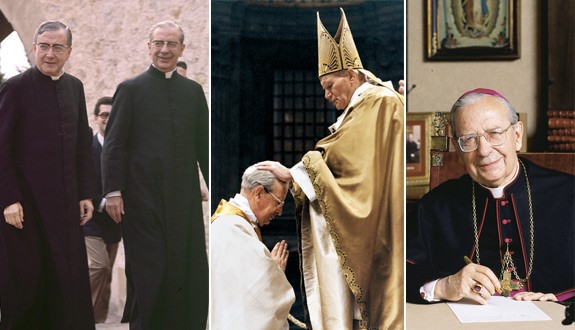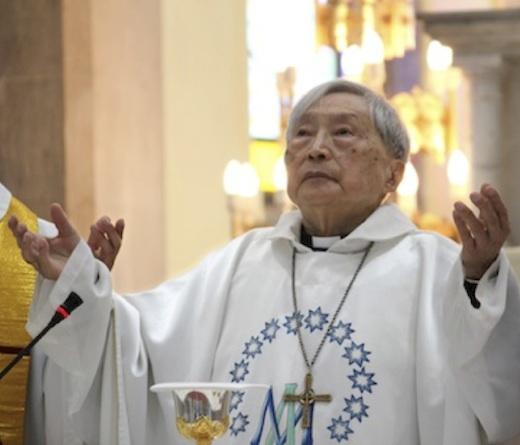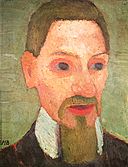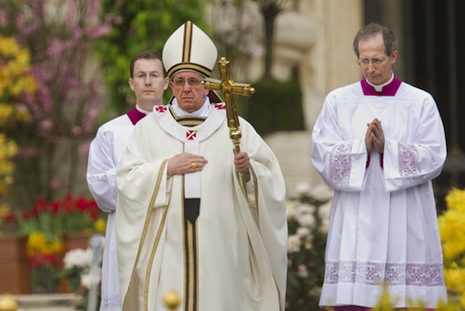【R.I.P】Bishop Fan Zhongliang Joseph

Soon after his death officials removed his biretta, a gesture to show they do not recognize his bishop’s status, a Church source told ucanews.com.
However, authorities have allowed two days for the faithful to pay their respects to the Jesuit bishop.
“They backed off as a result of a protest by the underground Church administrator, who threatened not to hold a Mass and let the officials face the resulting wrath of angry Catholics,” the source said.
Shanghai has lost a “steadfast and persevering” leader in Bishop Fan, said Anthony Lam Sui-ki, senior researcher at the Holy Spirit Study Centre in Hong Kong.
He was a well respected churchman, Lam said on Monday, noting that even all young priests from the “open” community went to get Bishop Fan’s blessing before they were ordained.
“Bishop Fan’s death will create the need for the underground bishops to get together for an election, even though it has been the secretariat operating the bishops’ conference for years,” Lam observed.
Asked whether such a meeting will bring a new crackdown on the Church, Lam said, “The government should be rational and understand that the Church is a peaceful group that does not bring any harm.”
There is now an urgent need for Auxiliary Bishop Thaddeus Ma Daqin of the “open” community to regain his freedom, though it is hard to predict how the government will handle his case, Lam added.
Bishop Ma has been under house arrest since he declared he would leave the government-sanctioned Catholic Patriotic Association during his episcopal ordination in July 7, 2012.
The diocese, under government pressure, suspended his ministry for two years, during which he cannot make public appearances. The suspension ends this July.
Bishop Fan was born in 1918 and baptized at 14 years old. He entered the Jesuit Society in 1938 and was ordained a priest in 1951.
In 1955, he and the then Bishop Ignatius Kung (Gong Pin-mei, who later became a cardinal) and a number of priests were thrown into prison accused of revolutionary crimes.
The future Bishop Fan was sentenced to 20 years imprisonment in Qinghai province, during which it became his job to carry corpses to a cemetery.
After his release, he became a high school teacher before being allowed to return to Shanghai.
He was secretly ordained as coadjutor bishop of Shanghai in 1985 and succeeded Cardinal Kung when he died in 2000.
Bishop Fan found himself under strict surveillance for decades.
“His name ‘Zhong’ and ‘Liang’ [loyal and kind] reflected his virtues throughout his life,” a layperson said on Monday.
Ven. Alvaro del Portillo, Faithful Steward and Spiritual Father

Today, March 11, 2014, marks the centenary of the birth of Alvaro del Portillo (1914-1994), bishop and first successor of St. Josemaría Escriva, founder of Opus Dei. Later this year, on September 27, he will be beatified in Madrid, the city where he was born, the third of eight children born to Ramon del Portillo and his wife Clementina Diez de Sollano, devout Catholic parents.
The early years and ordination
Alvaro, as a young boy, was studious and pious; to his classmates he was cheerful and kind. It seemed natural for him as a university student to join the St. Vincent de Paul Society in order to help the poor. It was during this time, while teaching catechism in a poor neighborhood, that he and his companions were attacked by a mob of men. Alvaro, although receiving a deep gash on his forehead, managed to escape. He tried unsuccessfully to hide the incident from his family, but nevertheless returned to visit the same poor neighborhoods.
When Alvaro was 19 a friend introduced him to Father Josemaría Escriva. That introduction made a very positive and deep impression on him. After a second meeting with Father Josemaría, Alvaro agreed to postpone a family vacation in order to attend a monthly retreat day. On that very same day, Alvaro asked to join Opus Dei, which, in 1935, was a very small group of men and women seeking to live holiness in everyday life. Subsequently, Alvaro obtained a degree in construction management, followed by a degree in civil engineering.
From the moment he discovered his vocation as a celibate layman, Alvaro began to work with Father Josemaría to spread the message of Opus Dei throughout Spain. This often meant traveling to other cities on the weekends, returning on rickety old trains at daybreak on Monday just in time for work. Soon afterwards, the Spanish Civil War (1936-1939)-a dangerous time of persecution for many priests and practicing Catholics-caused Alvaro to spend a few months in hiding with Father Josemaría in Madrid. Later, Alvaro was able to rejoin Father Josemaría, who had earlier escaped over the Pyrenees Mountains into France and traveled to Burgos on the National Side of Spain.
White Horse Temple, Luoyang

The White Horse Temple (Baima Si) in Luoyang, Henan Province, was the first Buddhist temple in China, established by Emperor Mingdi in the year 68 AD. The historic, leafy site features several ancient buildings and a highly devotional atmosphere.
History
According to legend, the Eastern Han emperor Mingdi dreamed of a golden figure flying over his palace with the sun and moon behind its head. The emperor told his ministers about the dream, and they suggested the figure may be the Buddha in India.
A delegation was thus sent to India to learn more about Buddhism. After three years, the delegation returned with two eminent Indian Buddhit monks, She Moteng and Zhu Falan (also spelled Kasyapamatanga and Dharmavanya or Moton and Chufarlan). The monks brought with them a white horse carrying a bundle of Buddhist sutras and figures.
The next year, the emperor ordered the construction of White Horse Temple to honor the arrival of Buddhism in China and the horse that carried back the sutras. It was China’s first Buddhist temple. The introduction of Buddhism in China would have a significant influence not only in the religious sphere, but on Chinese morals, philosophy and ethics.
The first Chinese version of the Sutra of Forty-two Sections was produced at the White Horse Temple, and the temple increased in importance as Buddhism grew within China and spread to Korea, Japan and Vietnam.
In 258, a royal Kuchean monk, Po-Yen, translated six Buddhist texts into Chinese at the temple, including the important Infinite Life Sutra. In 1992, with the assistance of Thai and Chinese donors, the Hall of the Thai Buddha was constructed slightly west of the old temple.
What to See
The layout of Baima Si is in keeping with the founding legend – there are two stone horses, one on either side of the entrance, and the tombs of the two Indian monks (earthen mounds surrounded by round stone walls), lie in the first courtyard.
Home to a thriving community of Buddhist monks, the temple is primarily a place of worship and not all areas are open to tourists. Over-inquisitive visitors are tactfully but firmly pointed in the right direction. A sense of peace and quiet pervades the leafy complex, in marked contrast to the busy highway and pushy souvenir sellers outside.
The complex covers an area of 200mu and faces south. A stone archway has been recently built 150 metres in front of the original gate. Between the archway and gate lies a pool with fountains, spanned by three stone bridges.
The visitor first encounters the Hall of Celestial Guardians (or Heavenly Kings), originally built in the Yuan Dynasty and decorated in the Qing Dynasty. Beyond this is the Main Hall (or Hall of Great Buddha), from the Ming Dynasty, which houses a large statue of Sakyamuni Buddha flanked by figures of Manjusri and Samantabhadra.
Near the Great Altar in the Main Hall is an ancient bell weighing more than a ton. It is still struck in time with the chanting of the monks. Its inscription reads: “The sound of the Bell resounds in Buddha’s temple causing the ghosts in Hell to tremble with fear.”
Behind the Main Hall is the Cool and Clear Terrace, where it is said the original sutras brought by the white horse were stored and translated.
【R.I.P】Bishop Fan Zhongliang Joseph went to the Lord
Bishop Fan Zhongliang Joseph Dear Brothers in Christ,

We have been informed that Bishop Fan Zhongliang Joseph went peacefully to the Lord on March 16, 2014 in Shanghai, at 5:58pm.
Bishop Fan was born on Jan. 13, 1918 in Huating, Songjiang county, Jiangsu province. He entered the Society on Aug. 30, 1938, at Zikawei, Shanghai, was ordained priest on May 31, 1951, and was consecrated bishop on Feb. 27, 1985.
All priests of the Chinese Province will celebrate one Mass first intention for Bishop Fan’s eternal rest. Those who are not priests will offer one Mass and Communion and recite one “corona”.
Yours in Our Lord,
Luciano Morra, S.J.
Socius
March 17, 2014
【R.I.P】Bishop Jin Luxian Aloysius went to the Lord
Bishop Aloysius Jin Luxian of Shanghai
Dear Brothers in Christ,

We have been informed that Bishop Jin Luxian Aloysius went peacefully to the Lord on Apr. 27, 2013 in Shanghai, at 2:45pm.
Bishop Jin was born on June 16, 1916 in Shanghai. He entered the Society on Aug. 30, 1938, at Zikawei, Shanghai, was ordained priest on May 19,1945, professed the last vows on Dec. 8, 1953, and was consecrated bishop on Jan. 27, 1985.
All priests of the Chinese Province will celebrate one Mass first intention for Bishop Jin’s eternal rest. Those who are not priests will offer one Mass and Communion and recite one “corona”.
Yours in Our Lord,
Luciano Morra, S.J.
Socius
April 27, 2013
First Unitarian Church, Baltimore

There are many First Unitarian Churches in the United States, but the First Unitarian Church in Baltimore really deserves the name. It was here in 1819 that Unitarianism was first defined as a denomination.
History
The First Unitarian Church of Baltimore was founded as the “First Independent Church of Baltimore” in 1817. The architect was Maximilien Godefroy, who also designed St. Mary’s Seminary Chapel and Battle Monument in Baltimore.
On May 5, 1819, Dr. William Ellery Channing (1780-1842) delivered the “Baltimore Sermon” that defined the newly emerging Unitarian denomination in America. The occasion was the ordination of a minister, and Channing took the opportunity to explain the beliefs of the church. He began,
He went on to explain why the doctrine of the Trinity should be rejected, which is the main defining characteristic of Unitarians. The Unitarians joined with the Universalists in 1961, forming today’s Unitarian Universalist denomination.
The church building has remained mostly unchanged since its construction. The architect Joseph E. Sperry added a barrel vault ceiling as part of a renovation in 1893, in order to correct the poor acoustics of the original dome. The church was added to the National Register of Historic Places in 1972.
What to See
The First Unitarian Church is Neoclassical in style, a large white cube topped with a dome. It is fronted with a portico or narthex with three round arches.
The facade is adorned with a terra cotta relief of the “Angel of Truth,” originally sculpted by Antonio Capellano. On a scroll is a Greek inscription that translates “To the One God.” The present relief is a replica, made by Baltimore sculptor Henry Berge (1908-1998) in the late 1950s to replace the decayed original.
Inside, the wide nave is topped with a barrel vault of 1893. The organ also dates from 1893. The chancel is decorated with a large mosaic of the Last Supper and stained glass windows, both from the studios of Louis Comfort Tiffany.
Fr. General’s Visit to Asia Pacific

16 Jan 2014: Fr. General gave a speech on Jesuit education to a packed auditorium of administrators, faculty and staff of the Jesuit University in Seoul, Sogang. Fr. General received a standing ovation at the end of his speech, a very rare occurrence at Sogang. At the reception after Mass, he was besieged by requests for photos for almost an hour.
18 Jan 2014: Fr. General arrived in Dili, East Timor. He is warmly greeted at the airport by Jesuits, candidates, and students of the new Jesuit high school he will bless, the Collegio Santo Inacio Loiola. They were led by Fr. Mark Raper, the President of the Jesuit Conference of Asia Pacific and the Regional Superior of East Timor.
19 Jan 2014: After meeting the Jesuits of East Timor, Fr. General received the final vows of Fr. Violanto da Costa Soares in the presence of Fr. Violanto’s family and his brother Jesuits. Fr. General’s also met with the families of our East Timorese Jesuits.
Source: Facebook updates from Fr. Daniel Patrick Huang, SJ
God speaks to each of us as he makes us…

I very much admire the poetry of Rainer Maria Rilke and the following is one of which I’m particularly fond:
God speaks to each of us as he makes us,
then walks with us silently out of the night.
These are the words we dimly hear:
You, sent out beyond your recall,
go to the limits of your longing.
Embody me.
Flare up like flame
and make big shadows I can move in.
You can read the entire poem here.
Pope Francis describes the bishops the Church needs

Pope Francis met on February 27 with the members of the Congregation for Bishops, and spoke at some length about the characteristics of the leaders the Church needs.
In the process of appointing bishops, the Pope said: “This Congregation exists to ensure that the name chosen has first of all been pronounced by the Lord.” He asked the members of the Congregation to look for priests who have dedicated themselves to the Lord and will draw others to Him.
“There does not exist a standard pastor for all churches,” the Pope said; the particular needs of each diocese will call for different sorts of bishops. But all bishops must possess some common characteristics: “Professionalism, service, and holiness of life: if we turn away from these three virtues we fall from the greatness to which we are called.”
Pope Francis reminded the congregation that when the original apostles set out to replace Judas, they agreed that the new apostle must be “a witness to the Resurrection.” This requirement remains today, he said; the bishop must be a witness to the resurrected Christ. He continued:
Men who are guardians of doctrine, not so as to measure how far the world is from doctrinal truth, but in order to fascinate the world … with the beauty of love, with the freedom offered by the Gospel. The Church does not need apologists for her causes or crusaders for her battles, but humble and trusting sowers of the truth, who know that it is always given to them anew and trust in its power.
A bishop should also be a man of prayer, the Pope said. He should pray constantly for the welfare of his diocese. “A man who does not have the courage to argue with God on behalf of his people cannot be a bishop,” he argued.
The Pontiff offered some cautions to the congregation in the selection of bishops. “We must rise above and overcome any eventual preferences, sympathies, provenances, or tendencies,” he said. And regarding the candidates, he added: “Be careful that they are not ambitious, that they are not in quest of the episcopate.” He went on to say that a bishop who is chosen to serve one particular Church should not look for another assignment. The Pope said bluntly: “This is called adultery.”
While acknowledging that it is difficult to find the priests who have all of the characteristics necessary for a good bishop, the Pope told the congregation that he had no doubt such men could be found, because Jesus would not abandon his Church.
Retreat for Lent 2014

Welcome to the Pray-as-you-go & Sacred Space Lent retreat. A retreat is time out from the normal whirl of events to look back on what has happened, take stock of where you are at and make any necessary changes for a better future. God is always working with us, gently urging, communicating and seeking contact, and our job is to give time to try and respond – however that may be. A time of retreat is a time of prayer; and a time of prayer is a time when we can be open and honest with God, trying to simply spend time with God, and trying to work out how best to respond. Saint Ignatius reminds us that God is in our deepest desires. Listening to the desires of our hearts means becoming quiet within, taking a step back, allowing things to surface, and listening to God’s voice. In order to be able to hear the voice of God, it’s important to dedicate time to the retreat. Work out a schedule that best works for your way of life, a period of time which best suits the rythmn of your day. Try and be faithful to it. One session will be released for each week of Lent, so try and work out a time when you can use it, but however you use it, try and let the desire to meet the Lord grow in you. Each of the readings of this retreat is designed to support you in this endeavour.




